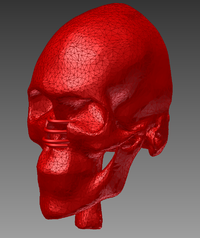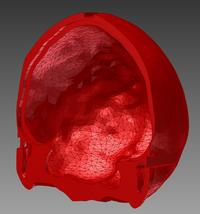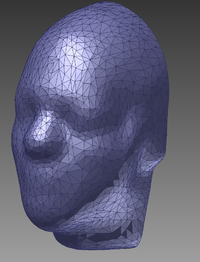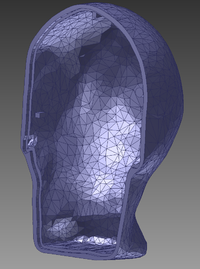Difference between revisions of "MGH Angel 001"
| Line 9: | Line 9: | ||
| [[File:Angell001 skull back.png | 200px | thumb | right]] | | [[File:Angell001 skull back.png | 200px | thumb | right]] | ||
|} | |} | ||
| − | |||
| − | |||
| − | |||
{| class="wikitable floatright" | {| class="wikitable floatright" | ||
|+ Front and back halves of the outer compartment | |+ Front and back halves of the outer compartment | ||
| Line 18: | Line 15: | ||
| [[File:Angell001 outer back.png | 200px | thumb | right]] | | [[File:Angell001 outer back.png | 200px | thumb | right]] | ||
|} | |} | ||
| − | |||
| − | |||
| − | |||
This phantom was created based on the automatic segmentation of a human subject. Surfaces were created using the marching cube algorithm ("isosurface" function in Matlab) and were simplified using Meshlab ("Laplacian Smooth" and "Quadric Edge Collapse Decimation" functions). | This phantom was created based on the automatic segmentation of a human subject. Surfaces were created using the marching cube algorithm ("isosurface" function in Matlab) and were simplified using Meshlab ("Laplacian Smooth" and "Quadric Edge Collapse Decimation" functions). | ||
The phantom consists of two nested compartments. The inner compartment is the skull, which is 3D printed as two matching parts (since bone has a low conductivity, plastic somewhat mimics this material). These parts, especially the front half of the skull, contain many complex details and therefore should be printed using dissoluble support material. The skull contain an inner compartment to be filled using a brain-like gel (this brain compartment is uniform and does not mimic the grey and white matter nor the CSF-filled ventricles). | The phantom consists of two nested compartments. The inner compartment is the skull, which is 3D printed as two matching parts (since bone has a low conductivity, plastic somewhat mimics this material). These parts, especially the front half of the skull, contain many complex details and therefore should be printed using dissoluble support material. The skull contain an inner compartment to be filled using a brain-like gel (this brain compartment is uniform and does not mimic the grey and white matter nor the CSF-filled ventricles). | ||
| − | The outer compartment is | + | The outer compartment is an outer shell in which the skull compartment slides (there are 3 sliding groves). When assembling the skull compartment inside the outer shell, you should make sure to add epoxy in the sliding grooves to make sure that the skull is secure inside the outer shell. |
Revision as of 13:10, 24 March 2015
If you use the material below, please cite aaaa
Download the latest version of the STL and Inventor files here.
This phantom was created based on the automatic segmentation of a human subject. Surfaces were created using the marching cube algorithm ("isosurface" function in Matlab) and were simplified using Meshlab ("Laplacian Smooth" and "Quadric Edge Collapse Decimation" functions). The phantom consists of two nested compartments. The inner compartment is the skull, which is 3D printed as two matching parts (since bone has a low conductivity, plastic somewhat mimics this material). These parts, especially the front half of the skull, contain many complex details and therefore should be printed using dissoluble support material. The skull contain an inner compartment to be filled using a brain-like gel (this brain compartment is uniform and does not mimic the grey and white matter nor the CSF-filled ventricles). The outer compartment is an outer shell in which the skull compartment slides (there are 3 sliding groves). When assembling the skull compartment inside the outer shell, you should make sure to add epoxy in the sliding grooves to make sure that the skull is secure inside the outer shell.



